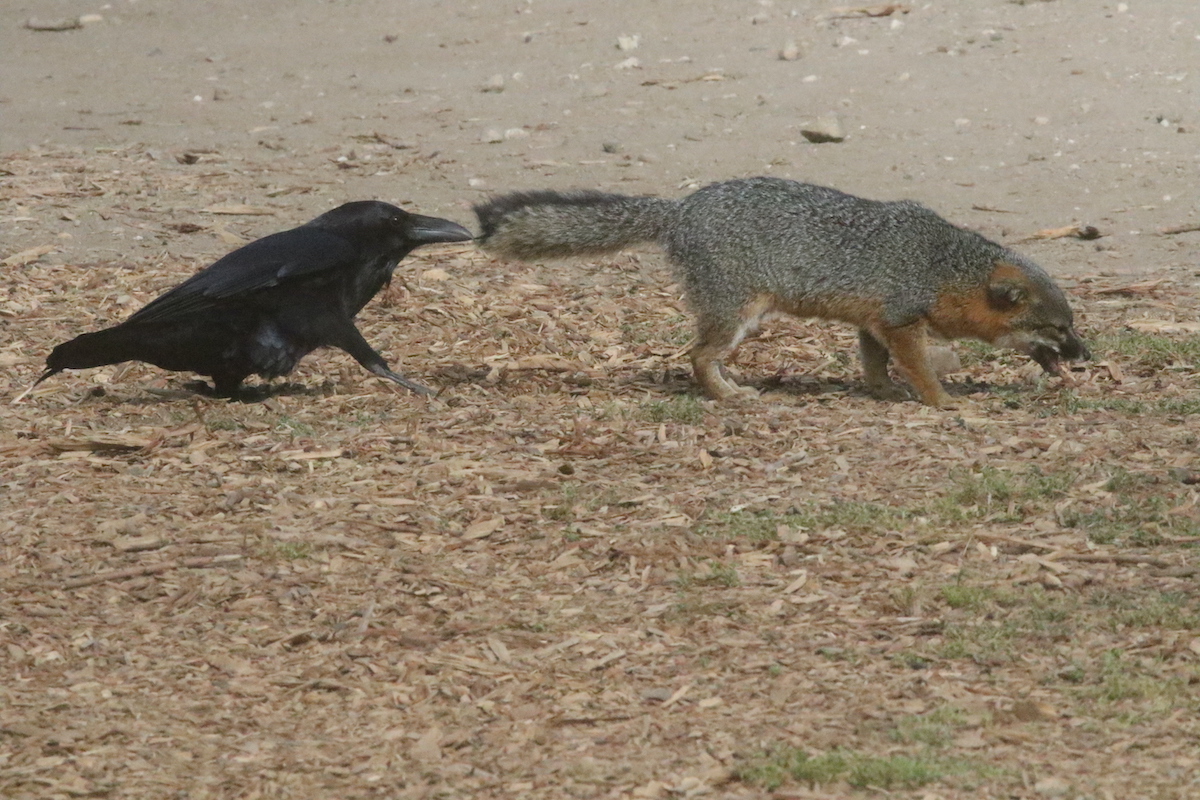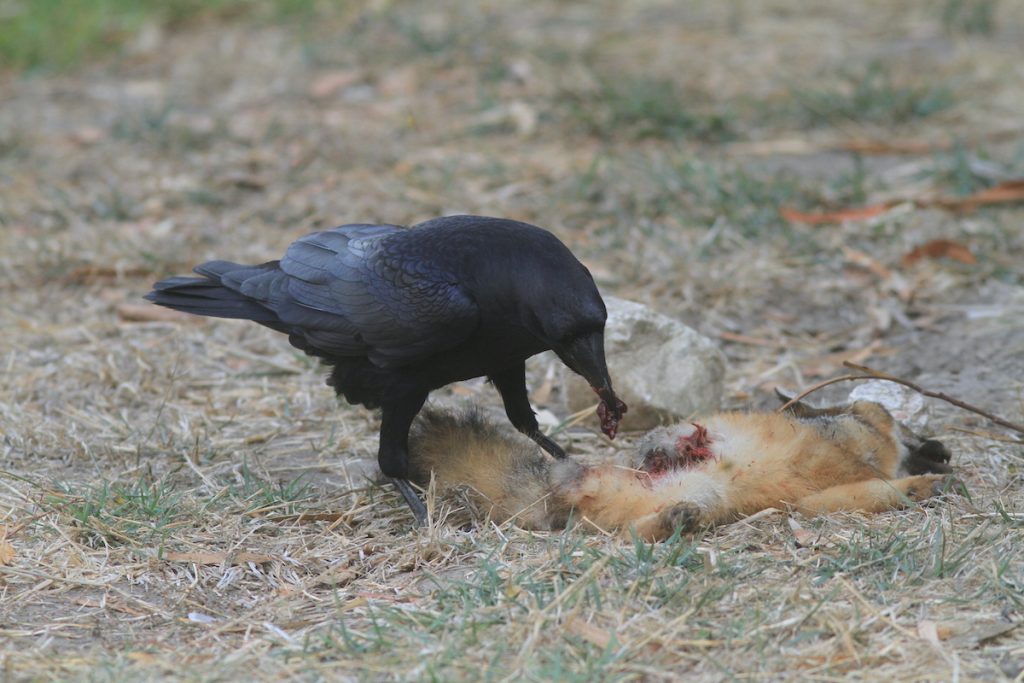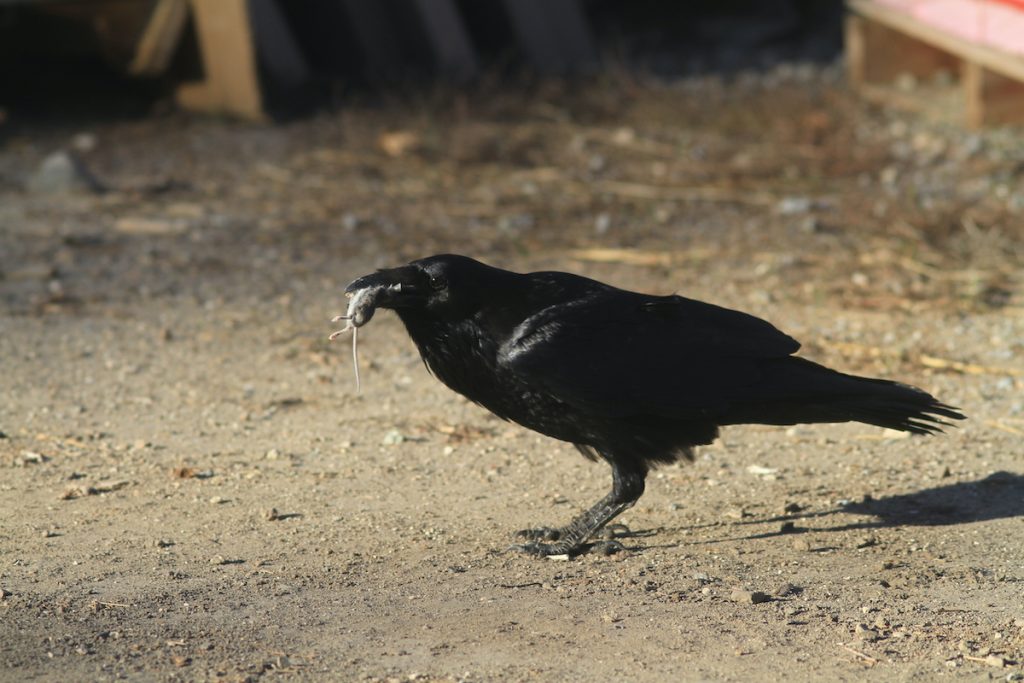Those Ruthless Devils

…and I say that with all due respect to one of the smartest and cleverest birds on the planet. I’ve also known, for years, that I’m up against a most formidable opponent. Having guided a kayak tour at Prisoners Harbor on the north side of Santa Cruz Island, I returned to my backpack tucked away at the end of the pier beneath a picnic table. This was close to 20 years ago, but even then I was very aware the ravens on the Channel Islands were especially adept at pilfering the contents from anything zipped up, especially the ravens at Scorpion Anchorage and Prisoners Harbor.
Before departing to guide my kayak tour, I’d made sure I flipped my pack over with the zippers concealed. When I returned it was obvious my pack had been moved, and the top outside pocket was unzipped. Then I noticed my car keys hanging on for dear life at the edge of the pier. Ravens love glittery items, things that might reflect in the sun. One of them had flung my keys. Half the keys were hanging over the edge of the pier, the others hung in there, thus keeping me sane.
Waiting for the Boat
At Scorpion Anchorage, the ravens wait patiently for the Island Packers ferry to arrive. Ravens know opportunity can be had, and a lot of them are found throughout the lower region of Scorpion Canyon. Once visitors disembark the ferry, the ravens scope out unattended packs, even though everyone coming off the boat has been warned about the ravens by the park rangers. What would the world be if we didn’t heed a fair warning? I can’t tell you how many times I’ve had to pile cobblestones on top of unattended packs on the beach at Scorpion Anchorage. People literally walk away from their belongings and believe that when they return their property will be untouched.
Personally, I’m fully aware of the ravens’ skillset. What I’m guilty of is sometimes thinking I can leave my camera pack out for just a moment, quickly attend to something in the old corral in Scorpion Canyon where we keep our kayaking gear, and trust that my pack will remain unscathed by any raven shenanigans. The last time I did that was a couple years ago. I dropped my pack, leaning it against the guide shed, and ran off to fill out my trip sheet. Maybe one minute passed. Maybe. When I returned, I saw a raven flying off with my wallet. There was a moment of sheer dread in my gut as I must have looked like an utter fool chasing after a bird that’s proven to be smarter than me.

As the raven flew off, my wallet’s contents rained back down to earth. Twenty-dollar bills gently floated to the ground, my credit and debit cards fluttered through the air, yet my driver’s license stayed with the wallet, which I managed to retrieve. Once ravens have claimed something, they’ll momentarily stop to eat what they’ve stolen, or to otherwise inspect their haul to see what is of most interest. That was my opportunity to throw a stick at this particular raven in hopes it would leave my wallet, which it did. Crisis averted.
Learned Behavior
There’s a couple of ravens in the lower and upper campgrounds of Scorpion Anchorage that are well-established. Both ravens have blue tags affixed to their wings. In 2021 these ravens were deemed “trouble birds” by the seabird biologists of Channel Islands National Park, who monitor seabird species that utilize the islands for breeding and nesting habitat. There’s a cave known as Bat Cave that houses a healthy sized ashy storm petrel colony. These seabirds are not much bigger than a bat and are nocturnal, but these two ravens had figured out where the cave was.
It’s possible these ravens had watched seabird biologists entering Bat Cave to monitor ashy storm petrel nests inside the dark, dank grotto. Those ravens then ravaged most of the petrel nests. Thereafter, the ravens were trapped and fitted with tags and GPS to monitor their travels. However, in the last couple years, the ravens haven’t been as active at Bat Cave. They’re still around Scorpion Canyon, but there never seems to be a shortage of available food.
Another example of their learned behavior is ravens watching western gulls and black oystercatchers to see what they are eating on Santa Cruz Island. As the tide drops and the intertidal zone becomes exposed, there’s more food available thanks to the barnacles and mussels. While kayaking around the Scorpion Anchorage area, I’ve seen ravens taking advantage of the intertidal zones, seeking out tiny invertebrates. Ravens simply take advantage of anything available.
Antagonists

There’s no love lost between island foxes and ravens. Mostly, though, island foxes ignore any harassment by ravens. As island foxes forage for food on the beach, ravens will hover nearby to see if the foxes can flush out any food items for the ravens to grab.
After leading a kayak tour and cleaning up gear at the corral, an island fox had found something in the leaf litter next to the road. As the fox fed on whatever it had discovered, a pesky raven was nearby and attempted to drive the fox away. At one point, the raven was tugging on the tip of the island foxes’ tail. The fox never even acknowledged the raven’s presence. The fox was not going to give in.
It’s no big surprise that one of the favorite food items of island foxes is the endemic deer mouse. They can sniff out mice anywhere, and the ravens are keen on this behavior. I once watched an island fox trying to flush a mouse out from under a woodpile with no success. However, the raven watching nearby waited for the fox to give up, and then hopped over to the wood pile. As the raven gently hopped up and down atop the wood pile the rattled mouse scurried out into the open. The raven hopped down behind the mouse and poked its spine with its beak leaving the rodent paralyzed. It quickly gulped the mouse down.
One of the most unusual experiences I’ve had with ravens was on an early morning just outside my tent in the lower campground in Scorpion Canyon. As I rolled out of my tent there were two ravens feeding on an island fox carcass. One of the ravens was aggressively gutting the fox. The other raven was timid. It pecked at the carcass as if the fox was going to rise up and go Tasmanian devil on the anxious corvid.
Always wary, always watching. Out on the islands, there isn’t much that the ravens miss. They are one of the many reasons Channel Islands National Park is one of the most unique archipelagos in the world.





